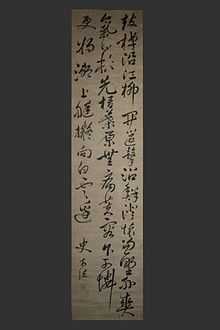Shi Kefa calligraphy

Shi Kefa (Chinese: 史可法; pinyin: Shǐ Kéfǎ; Wade–Giles: Shih Ke-fa; 1601—April 14, 1645), courtesy names Xianzhi (simplified Chinese: 宪之; traditional Chinese: 憲之; pinyin: Xiànzhī) and Daolin (simplified Chinese: 道邻; traditional Chinese: 道鄰; pinyin: Dàolín), was a government official and calligrapher of the late Ming Dynasty. He was born in Xiangfu (祥符; present-day Kaifeng, Henan) and claimed ancestry from Daxing County, Shuntianfu (順天府大興縣; in present-day Beijing). He was mentored by Zuo Guangdou (左光斗). Shi Kefa served as Grand Secretary in the Ministry of War in Nanjing during the early part of his career. He is best remembered for his defense of Yangzhou from invading armies of the Manchu-ruled Qing Dynasty. He was killed when Yangzhou fell to Qing forces in April 1645.
The Southern Ming government granted him a posthumous name of "Zhongjing" (忠靖; means "loyal and peaceful"). Nearly a century later, the Qing Dynasty's Qianlong Emperor granted Shi Kefa another posthumous name of "Zhongzheng" (忠正; means "loyal and upright".) His descendants collected his works and compiled them into a book titled Lord Shi Zhongzheng's Collections (史忠正公集). In 1984, his biography and edited writings were published in Shanghai. Shi Kefa was said to have been an individual of great energy and integrity, qualities reflected in his calligraphy, frequently in cursive and semi-cursive style. Shi Kefa's calligraphy is of the late Ming period style among other Ming literati, with a preference for long compositions in a flourishing manner. Cursive calligraphy especially allowed for a free expression in a deviation from strict classical standards.
References
- Arthur W. Hummel, Sr., ed., Eminent Chinese of the Ch’ing Period, Library of Congress, Washington, 1943, pp. 651-652.
- Yu Lianhua, Encyclopedia of Chinese Artists,Shanghai, 1980, p. 157.
- The Great Encyclopedia of China, Chinese History, vol. 2, pp. 937-938.